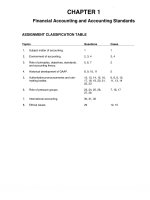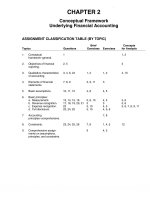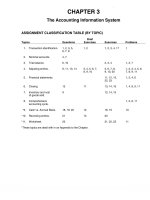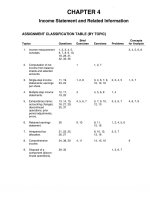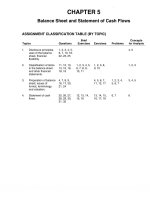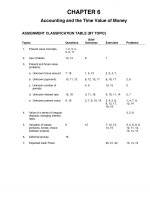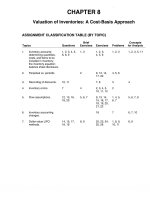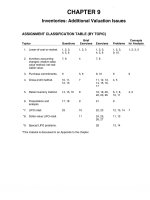Solution manual intermediate accounting 13e kieso ch07
Bạn đang xem bản rút gọn của tài liệu. Xem và tải ngay bản đầy đủ của tài liệu tại đây (517.74 KB, 86 trang )
To download more slides, ebook, solutions and test bank, visit
CHAPTER 7
Cash and Receivables
ASSIGNMENT CLASSIFICATION TABLE (BY TOPIC)
Topics
Questions
1.
Accounting for cash.
2.
Brief
Exercises
Concepts
for Analysis
Exercises
Problems
1, 2, 3, 4, 21, 1
22, 23, 24
1, 2
1
Accounting for accounts
receivable, bad debts,
other allowances.
5, 6, 7, 8, 9,
10, 11, 12,
13, 14, 15,
16, 20, 22,
23, 24
2, 3, 4, 5
3, 4, 5, 6,
7, 8, 9, 10,
11, 12, 14
2, 3, 4,
5, 6
1, 2, 3, 4,
5, 10, 11
3.
Accounting for notes
receivable.
14, 15, 25
6, 7
18, 19
8, 9, 10
6, 7, 8, 9
4.
Assignment and
factoring of accounts
receivable.
17, 18, 19
8, 9, 10,
11, 12
12, 13, 14,
15, 16, 17,
21
7, 11
4, 6, 8
5.
Analysis of receivables.
21
13
20, 21
1
*6.
Petty cash and bank
reconciliations.
26
14, 15, 16
22, 23,
24, 25
12, 13, 14
*7.
Loan impairments
27, 28
17
26, 27
15
*This material is covered in an Appendix to the chapter.
Copyright © 2010 John Wiley & Sons, Inc.
Kieso, Intermediate Accounting, 13/e, Solutions Manual
(For Instructor Use Only)
7-1
To download more slides, ebook, solutions and test bank, visit
ASSIGNMENT CLASSIFICATION TABLE (BY LEARNING OBJECTIVE)
Learning Objectives
1.
Identify items considered cash.
2.
Indicate how to report cash and related items.
3.
Define receivables and identify the different
types of receivables.
4.
Explain accounting issues related to
recognition of accounts receivable.
5.
Brief
Exercises
Exercises
1
1, 2
Problems
1
3, 4
6
2, 3
3, 4, 5, 6, 12
6
Explain accounting issues related to valuation
of accounts receivable.
4, 5
7, 8, 9, 10,
11, 12, 14
2, 3, 4, 5, 6
6.
Explain accounting issues related to
recognition of notes receivable.
6, 7
18, 19
8, 9, 10
7.
Explain accounting issues related to valuation
of notes receivable.
18, 19
10
8.
Explain accounting issues related to
disposition of accounts and notes receivable.
8, 9, 10,
11, 12
12, 13, 14, 15,
16, 17, 21
7, 11
9.
Describe how to report and analyze
receivables.
13
20
11
*10.
Explain common techniques employed
to control cash.
14, 15, 16
22, 23, 24, 25
12, 13, 14
*11.
Describe the accounting for a loan impairment.
17
26, 27
15
7-2
Copyright © 2010 John Wiley & Sons, Inc.
Kieso, Intermediate Accounting, 13/e, Solutions Manual
(For Instructor Use Only)
To download more slides, ebook, solutions and test bank, visit
ASSIGNMENT CHARACTERISTICS TABLE
Item
Description
Level of
Difficulty
E7-1
E7-2
E7-3
E7-4
E7-5
E7-6
E7-7
E7-8
E7-9
E7-10
E7-11
E7-12
E7-13
E7-14
E7-15
E7-16
E7-17
E7-18
E7-19
E7-20
E7-21
*E7-22
*E7-23
*E7-24
*E7-25
*E7-26
*E7-27
Determining cash balance.
Determine cash balance.
Financial statement presentation of receivables.
Determine ending accounts receivable.
Record sales gross and net.
Recording sales transactions.
Recording bad debts.
Recording bad debts.
Computing bad debts and preparing journal entries.
Bad-debt reporting.
Bad debts—aging.
Journalizing various receivable transactions.
Assigning accounts receivable.
Journalizing various receivable transactions.
Transfer of receivables with recourse.
Transfer of receivables with recourse.
Transfer of receivables without recourse.
Notes transactions at unrealistic interest rates.
Note receivable with unrealistic interest rate.
Analysis of receivables.
Transfer of receivables.
Petty cash.
Petty cash.
Bank reconciliation and adjusting entries.
Bank reconciliation and adjusting entries.
Impairments
Impairments
Moderate
Moderate
Simple
Simple
Simple
Moderate
Moderate
Simple
Simple
Simple
Simple
Simple
Simple
Simple
Simple
Moderate
Simple
Simple
Moderate
Moderate
Moderate
Simple
Simple
Moderate
Simple
Moderate
Moderate
10–15
10–15
10–15
10–15
15–20
5–10
10–15
5–10
8–10
10–12
8–10
15–20
10–15
15–18
10–15
15–20
10–15
10–15
20–25
10–15
10–15
5–10
10–15
15–20
15–20
15–25
15–25
P7-1
P7-2
P7-3
P7-4
P7-5
P7-6
P7-7
P7-8
P7-9
P7-10
P7-11
*P7-12
*P7-13
*P7-14
*P7-15
Determine proper cash balance.
Bad-debt reporting.
Bad-debt reporting—aging.
Bad-debt reporting.
Bad-debt reporting.
Journalize various accounts receivable transactions.
Assigned accounts receivable—journal entries.
Notes receivable with realistic interest rate.
Notes receivable journal entries.
Comprehensive receivables problem.
Income effects of receivables transactions.
Petty cash, bank reconciliation.
Bank reconciliation and adjusting entries.
Bank reconciliation and adjusting entries.
Loan impairment entries
Simple
Moderate
Moderate
Moderate
Moderate
Moderate
Moderate
Moderate
Moderate
Complex
Moderate
Moderate
Moderate
Moderate
Moderate
20–25
20–25
20–30
25–35
20–30
25–35
25–30
30–35
30–35
40–50
20–25
20–25
20–30
20–30
30–40
Copyright © 2010 John Wiley & Sons, Inc.
Kieso, Intermediate Accounting, 13/e, Solutions Manual
Time
(minutes)
(For Instructor Use Only)
7-3
To download more slides, ebook, solutions and test bank, visit
ASSIGNMENT CHARACTERISTICS TABLE (Continued)
Item
Description
CA7-1
CA7-2
CA7-3
CA7-4
CA7-5
CA7-6
CA7-7
CA7-8
Bad debt accounting.
Various receivable accounting issues.
Bad-debt reporting issues.
Basic note and accounts receivable transactions.
Bad-debt reporting issues.
Sale of notes receivable.
Zero-interest-bearing note receivable.
Reporting of notes receivable, interest, and sale
of receivables.
Accounting for zero-interest-bearing note.
Receivables management.
Bad-debt reporting, ethics.
CA7-9
CA7-10
CA7-11
7-4
Copyright © 2010 John Wiley & Sons, Inc.
Level of
Difficulty
Time
(minutes)
Simple
Simple
Moderate
Moderate
Moderate
Moderate
Moderate
Moderate
10–15
15–20
25–30
25–30
25–30
20–25
20–30
25–30
Moderate
Moderate
Moderate
25–30
25–30
25–30
Kieso, Intermediate Accounting, 13/e, Solutions Manual
(For Instructor Use Only)
To download more slides, ebook, solutions and test bank, visit
SOLUTIONS TO CODIFICATION EXERCISES
CE7-1
From the Master Glossary
(a) Consistent with common usage, cash includes not only currency on hand but demand deposits
with banks or other financial institutions. Cash also includes other kinds of accounts that have the
general characteristics of demand deposits in that the customer may deposit additional funds at
any time and also effectively may withdraw funds at any time without prior notice or penalty. All
charges and credits to those accounts are cash receipts or payments to both the entity owning the
account and the bank holding it. For example, a bank’s granting of a loan by crediting the proceeds to a customer’s demand deposit account is a cash payment by the bank and a cash receipt
of the customer when the entry is made.
(b) Securitization is the process by which financial assets are transformed into securities.
(c) Recourse is the right of a transferee of receivables to receive payment from the transferor of those
receivables for any of the following:
a. Failure of debtors to pay when due
b. The effects of prepayments
c. Adjustments resulting from defects in the eligibility of the transferred receivables.
CE7-2
According to FASB ASC 450-20-05 (Accruals of Loss Contingencies Do Not Provide Financial Protection)
05–8
Accrual of a loss related to a contingency does not create or set aside funds to lessen the
possible financial impact of a loss. Confusion exists between accounting accruals (sometimes
referred to as accounting reserves) and the reserving or setting aside of specific assets to be
used for a particular purpose or contingency. Accounting accruals are simply a method of allocating costs among accounting periods and have no effect on an entity’s cash flow. Those
accruals in no way protect the assets available to replace or repair uninsured property that may
be lost or damaged, or to satisfy claims that are not covered by insurance, or, in the case of
insurance entities, to satisfy the claims of insured parties. Accrual, in and of itself, proves no
financial protection that is not available in the absence of accrual.
05–9
An entity may choose to maintain or have access to sufficient liquid assets to replace or repair
lost or damaged property or to pay claims in case a loss occurs. Alternatively, it may transfer
the risk to others by purchasing insurance. The accounting standards set forth in this Subtopic
do not affect the fundamental business economics of that decision. That is a financial decision,
and if an entity’s management decides to do neither, the presence or absence of an accrued
credit balance on the balance sheet will have no effect on the consequences of that decision.
Insurance or reinsurance reduces or eliminates risks and the inherent earnings fluctuations that
accompany risks. Unlike insurance and reinsurance, the use of accounting reserves does not
reduce or eliminate risk. The use of accounting reserves is not an alternative to insurance and
reinsurance in protecting against risk. Earnings fluctuations are inherent in risk retention, and
they are reported as they occur.
Copyright © 2010 John Wiley & Sons, Inc.
Kieso, Intermediate Accounting, 13/e, Solutions Manual
(For Instructor Use Only)
7-5
To download more slides, ebook, solutions and test bank, visit
CE7-3
According to FASB ASC 860-10-05 (Overview and Background)
> Types of Transfers
05–6
Transfers of financial assets take many forms. This guidance provides an overview of the following types of transfers discussed in this Topic:
a.
Securitizations
b.
Factoring
c.
Transfers of receivables with recourse
d.
Securities lending transactions
e.
Repurchase agreements
f.
Loan participations
g.
Banker’s acceptances
>> Factoring
05–14 Factoring arrangements are a means of discounting accounts receivable on a nonrecourse,
notification basis. Accounts receivable are sold outright, usually to a transferee (the factor) that
assumes the full risk of collection, without recourse to the transferor in the event of a loss.
Debtors are directed to send payments to the transferee.
>> Transfers of Receivables with Recourse
05–15 In a transfer of receivables with recourse, the transferor provides the transferee with full or
limited recourse. The transferor is obligated under the terms of the recourse provision to make
payments to the transferee or to repurchase receivables sold under certain circumstances,
typically for defaults up to a specified percentage.
>> Securities Lending Transactions
05–16 Securities lending transactions are initiated by broker-dealers and other financial institutions
that need specific securities to cover a short sale or a customer’s failure to deliver securities
sold. Securities custodians or other agents commonly carry out securities lending activities on
behalf of clients.
>> Repurchase Agreements
05–19 Government securities dealers, banks, other financial institutions, and corporate investors commonly use repurchase agreements to obtain or use short-term funds. Under those agreements,
the transferor (repo party) transfers a security to a transferee (repo counterparty or reverse
party) in exchange for cash and concurrently agrees to reacquire that security at a future date
for an amount equal to the cash exchanged plus a stipulated interest factor. Instead of cash,
other securities or letters of credit sometimes are exchanged. Some repurchase agreements
call for repurchase of securities that need not be identical to the securities transferred.
>> Loan Participations
05–22 In certain industries, a typical customer’s borrowing needs often exceed its bank’s legal lending
limits. To accommodate the customer, the bank may participate the loan to other banks (that is,
transfer under a participation agreement a portion of the customer’s loan to one or more
participating banks).
7-6
Copyright © 2010 John Wiley & Sons, Inc.
Kieso, Intermediate Accounting, 13/e, Solutions Manual
(For Instructor Use Only)
To download more slides, ebook, solutions and test bank, visit
CE7-3 (Continued)
>> Banker’s Acceptances
05–24 Banker’s acceptances provide a way for a bank to finance a customer’s purchase of goods
from a vendor for periods usually not exceeding six months. Under an agreement between the
bank, the customer, and the vendor, the bank agrees to pay the customer’s liability to the
vendor upon presentation of specified documents that provide evidence of delivery and acceptance of the purchased goods. The principal document is a draft or bill of exchange drawn
by the customer that the bank stamps to signify its acceptance of the liability to make payment
on the draft on its due date.
CE7-4
According to FASB ASC 210-20-45
> Right of Setoff Criteria
45-1
A right of setoff exists when all of the following conditions are met:
a. Each of two parties owes the other determinable amounts.
b. The reporting party has the right to set off the amount owed with the amount owed by the
other party.
c. The reporting party intends to set off.
d. The right of setoff is enforceable at law.
45-2
A debtor having a valid right of setoff may offset the related asset and liability and report the
net amount.
45-3
If the parties meet the criteria specified in paragraph 210-20-45-1, specifying currency or interest
rate requirements is unnecessary. However, if maturities differ, only the party with the nearer
maturity could offset because the party with the longer term maturity must settle in the manner
that the other party selects at the earlier maturity date.
45-4
If a party does not intend to set off even though the ability to set off exists, an offsetting presentation in the statement of financial position is not representationally faithful.
45-5
Acknowledgment of the intent of set off by the reporting party and, if applicable, demonstration
of the execution of the setoff in similar situations meet the criterion of intent.
Copyright © 2010 John Wiley & Sons, Inc.
Kieso, Intermediate Accounting, 13/e, Solutions Manual
(For Instructor Use Only)
7-7
To download more slides, ebook, solutions and test bank, visit
ANSWERS TO QUESTIONS
1. Cash normally consists of coins and currency on hand, bank deposits, and various kinds of orders
for cash such as bank checks, money orders, travelers’ checks, demand bills of exchange, bank
drafts, and cashiers’ checks. Balances on deposit in banks which are subject to immediate withdrawal are properly included in cash. Money market funds that provide checking account privileges
may be classified as cash. There is some question as to whether deposits not subject to immediate
withdrawal are properly included in cash or whether they should be set out separately. Savings
accounts, time certificates of deposit, and time deposits fall in this latter category. Unless restrictions
on these kinds of deposits are such that they cannot be converted (withdrawn) within one year or
the operating cycle of the entity, whichever is longer, they are properly classified as current assets.
At the same time, they may well be presented separately from other cash and the restrictions as to
convertibility reported.
2. (a)
(b)
(c)
(d)
(e)
(f)
Cash
Trading securities.
Temporary investments.
Accounts receivable.
Accounts receivable, a loss if uncollectible.
Other assets if not expendable, cash if expendable for goods and services in the foreign country.
(g) Receivable if collection expected within one
year; otherwise, other asset.
(h)
(i)
(j)
(k)
(l)
(m)
Investments, possibly other assets.
Cash.
Trading securities.
Cash.
Cash.
Postage expense, or prepaid expense, or office supplies inventory.
(n) Receivable from employee if the
company is to be reimbursed;
otherwise, prepaid expense.
3. A compensating balance is that portion of any cash deposit maintained by an enterprise which
constitutes support for existing borrowing arrangements with a lending institution.
A compensating balance representing a legally restricted deposit held against short-term borrowing
arrangements should be stated separately among the cash and cash-equivalent items. A restricted
deposit held as a compensating balance against long-term borrowing arrangements should be
separately classified as a noncurrent asset in either the investments or other assets section.
4. Restricted cash for debt redemption would be reported in the long-term asset section, probably in
the investments section. Another alternative is the other assets section. Given that the debt is long
term, the restricted cash should also be reported as long term.
5. The seller normally uses trade discounts to avoid frequent changes in its catalogs, to quote different
prices for different quantities purchased, and to hide the true invoice price from competitors. Trade
discounts are not recorded in the accounts because the price finally quoted is generally an
accurate statement of the fair market value of the product on that date. In addition, no subsequent
changes can occur to affect this value from an accounting standpoint. With a cash discount, the
buyer receives a choice and events subsequent to the original transaction dictate that additional
entries may be needed.
7-8
Copyright © 2010 John Wiley & Sons, Inc.
Kieso, Intermediate Accounting, 13/e, Solutions Manual
(For Instructor Use Only)
To download more slides, ebook, solutions and test bank, visit
Questions Chapter 7 (Continued)
6. Two methods of recording accounts receivable are:
1. Record receivables and sales gross.
2. Record receivables and sales net.
The net method is desirable from a theoretical standpoint because it values the receivable at its
net realizable value. In addition, recording the sales at net provides a better assessment of the
revenue that was earned from the sale of the product. If the purchasing company fails to take the
discount, then the company should reflect this amount as income. The gross method for
receivables and sales is used in practice normally because it is expedient and its use does not
generally have any significant effect on the presentation of the financial statements.
7. The basic problems that relate to the valuation of receivables are (1) the determination of the face
value of the receivable, (2) the probability of future collection of the receivable, and (3) the length
of time the receivable will be outstanding. The determination of the face value of the receivable is a
function of the trade discount, cash discount, and certain allowance accounts such as the Allowance
for Sales Returns and Allowances.
8. The theoretical superiority of the allowance method over the direct write-off method of accounting
for bad debts is two-fold. First, since revenue is considered to be recognized at the point of sale on
the assumption that the resulting receivables are valid liquid assets merely awaiting collection, periodic income will be overstated to the extent of any receivables that eventually become uncollectible.
The proper matching of revenue and expense requires that gross sales in the income statement be
partially offset by a charge to bad debt expense that is based on an estimate of the receivables
arising from gross sales that will not be converted into cash.
Second, accounts receivable on the balance sheet should be stated at their estimated net realizable value. The allowance method accomplishes this by deducting from gross receivables the
allowance for doubtful accounts. The latter is derived from the charges for bad debt expense on
the income statement.
9. The percentage-of-sales method. Under this method Bad Debt Expense is debited and Allowance
for Doubtful Accounts is credited with a percentage of the current year’s credit or total sales. The
rate is determined by reference to the relationship between prior years’ credit or total sales and
actual bad debts arising therefrom. Consideration should also be given to changes in credit policy
and current economic conditions. Although the rate should theoretically be based on and applied to
credit sales, the use of total sales is acceptable if the ratio of credit sales to total sales does not
vary significantly from year to year.
The percentage-of-sales method of providing for estimated uncollectible receivables is intended to
charge bad debt expense to the period in which the corresponding sales are recorded and is,
therefore, designed for the preparation of a fair income statement. Due to annually insignificant but
cumulatively significant errors in the experience rate which may result in either an excessive or
inadequate balance in the allowance account, however, this method may not accurately report
accounts receivable in the balance sheet at their estimated net realizable value. This can be
prevented by periodically reviewing and, if necessary, adjusting the balance in the allowance
account. The materiality of any such adjustment would govern its treatment for reporting purposes.
The necessity of such adjustments of the allowance account indicates that bad debt expenses
have not been accurately matched against related sales. Further, even when the experience rate
does not result in an excessive or inadequate balance in the allowance account, this method tends
to have a smoothing effect on reported periodic income due to year-to-year differences between
the amounts of bad debt write-offs and estimated bad debts.
Copyright © 2010 John Wiley & Sons, Inc.
Kieso, Intermediate Accounting, 13/e, Solutions Manual
(For Instructor Use Only)
7-9
To download more slides, ebook, solutions and test bank, visit
Questions Chapter 7 (Continued)
The aging method. With this method each year’s debit to the expense account and credit to the
allowance account are determined by an evaluation of the collectibility of open accounts receivable
at the close of the year. An analysis of the accounts according to their due dates is the usual
procedure. For each of the age categories established in the analysis, average percentage rates
may be developed on the basis of past experience and applied to the accounts in the respective
age categories. This method may also utilize individual analysis for some accounts, especially
those that are considerably past due, in arriving at estimated uncollectible receivables. On the
basis of the foregoing analysis the balance in the valuation account is then adjusted to the amount
estimated to be uncollectible.
This method of providing for uncollectible accounts is quite accurate for purposes of reporting
accounts receivable at their estimated net realizable value in the balance sheet. From the standpoint of the income statement, however, the aging method may not match accurately bad debt
expenses with the sales which caused them because the charge to bad debt expense is not based
on sales. The accuracy of both the charge to bad debt expense and the reported value of receivables depends on the current estimate of uncollectible accounts. The accuracy of the expense
charge, however, is additionally dependent upon the timing of actual write-offs.
10. A major part of accounting is the measurement of financial data. Changes in values should be
recognized as soon as they are measurable in objective terms in order for accounting to provide
useful information on a periodic basis.
The very existence of accounts receivable is based on the decision that a credit sale is an objective indication that revenue should be recognized. The alternative is to wait until the debt is paid in
cash. If revenue is to be recognized and an asset recorded at the time of a credit sale, the need for
fairness in the statements requires that both expenses and the asset be adjusted for the estimated
amounts of the asset that experience indicates will not be collected.
The argument may be persuasive that the evidence supporting write-offs permits a more accurate
decision than that which supports the allowance method. The latter method, however, is “objective”
in the sense in which accountants use the term and is justified by the need for fair presentation of
receivables and income. The direct write-off method is not wholly objective; it requires the use of
judgment in determining when an account has become uncollectible.
11. Because estimation of the allowance requires judgment, management could either over-estimate
or under-estimate the amount of uncollectible accounts depending on whether a higher or lower
earnings number is desired. For example, Sun Trust bank (referred to in the chapter) was having a
very profitable year. By over-estimating the amount of bad debts, Sun Trust could record a higher
allowance and expense, thereby reducing income in the current year. In a subsequent year, when
earnings are low, they could under-estimate the allowance, record less expense and get a boost to
earnings.
12. The receivable due from Bernstein Company should be written off to an appropriately named loss
account and reported in the income statement as part of income from operations. Note that the
profession specifically excludes write-offs of receivables from being extraordinary. In this case,
classification as an unusual item would seem appropriate. The loss may properly be reduced by
the portion of the allowance for doubtful accounts at the end of the preceding year that was
allocable to the Bernstein Company account.
Estimates for doubtful accounts are based on a firm’s prior bad debt experience with due consideration
given to changes in credit policy and forecasted general or industry business conditions.
7-10
Copyright © 2010 John Wiley & Sons, Inc.
Kieso, Intermediate Accounting, 13/e, Solutions Manual
(For Instructor Use Only)
To download more slides, ebook, solutions and test bank, visit
Questions Chapter 7 (Continued)
The purpose of the allowance method is to anticipate only that amount of bad debt expense which
can be reasonably forecasted in the normal course of events; it is not intended to anticipate bad
debt losses which are abnormal and nonrecurring in nature.
13. If the direct write-off method is used, the only alternative is to debit Cash and credit a revenue
account entitled Uncollectible Amounts Recovered. If the allowance method is used, then the
accountant may debit Accounts Receivable and credit the Allowance for Doubtful Accounts. An
entry is then made to credit the customer’s account and debit Cash upon receipt of the remittance.
14. The journal entry on Lombard’s books would be:
Notes Receivable ............................................................................................
Discount on Notes Receivable...............................................................
Sales Revenue ..........................................................................................
1,000,000
360,000
640,000*
*Assumes that seller is a dealer in this property. If not, the property might be credited, and a loss
on sale of $50,000 would be recognized.
15. Imputed interest is the interest ascribed or attributed to a situation or circumstance which is void of
a stated or otherwise appropriate interest factor. Imputed interest is the result of a process of interest
rate estimation called imputation.
An interest rate is imputed for notes receivable when (1) no interest rate is stated for the transaction,
or (2) the stated interest rate is unreasonable, or (3) the stated face amount of the note is
materially different from the current cash price for the same or similar items or from the current
market value of the debt instrument.
In imputing an appropriate interest rate, consideration should be given to the prevailing interest
rates for similar instruments of issuers with similar credit ratings, the collateral, and restrictive
covenants.
16. The fair value option gives companies the option of using fair value as the measurement basis for
financial instruments. The Board believes that fair value measurement for financial instruments
provides more relevant and understandable information than historical cost. If companies choose
the fair value option, the receivables are recorded at fair value, with unrealized gains or losses
reported as part of net income.
17. A company might sell receivables because money is tight and access to normal credit is not
available or prohibitively expensive. Also, a company may have to sell its receivables, instead of
borrowing, to avoid violating existing lending arrangements. In addition, billing and collection of
receivables are often time-consuming and costly.
18. A financial components approach is used when receivables are sold but there is continuing involvement by the seller in the receivable. Examples of continuing involvement are recourse provisions
or continuing rights to service the receivable. A transfer of receivables should be recorded as a
sale when the following three conditions are met:
(a) The transferred asset has been isolated from the transferor (put beyond reach of the transferor and its creditors).
(b) The transferees have obtained the right to pledge or exchange either the transferred assets or
beneficial interests in the transferred assets.
(c) The transferor does not maintain effective control over the transferred assets through an
agreement to repurchase or redeem them before their maturity.
Copyright © 2010 John Wiley & Sons, Inc.
Kieso, Intermediate Accounting, 13/e, Solutions Manual
(For Instructor Use Only)
7-11
To download more slides, ebook, solutions and test bank, visit
Questions Chapter 7 (Continued)
19. Recourse is a guarantee from Moon that if any of the sold receivables are uncollectible, Moon will
pay the factor for the amount of the uncollectible account. This recourse obligation represents
continuing involvement by Moon after the sale. Under the financial components model, the estimated fair value of the recourse obligation will be reported as a liability on Moon’s balance sheet.
20. Several acceptable solutions are possible depending upon assumptions made as to whether certain
items are collectible within the operating cycle or not. The following illustrates one possibility:
Current Assets
Accounts receivable—Trade (of which accounts in the amount
of $75,000 have been assigned as security for loans payable)
($523,000 + $75,000) ............................................................................................................
Federal income tax refund receivable ................................................................................
Advance payments on purchases.......................................................................................
Investments
Advance to subsidiary ...........................................................................................................
Other Assets
Travel advance to employees..............................................................................................
Notes receivable past due plus accrued interest .............................................................
$598,000
15,500
61,000
45,500
22,000
47,000
21. The accounts receivable turnover ratio is computed by dividing net sales by average net receivables outstanding during the year. This ratio is used to assess the liquidity of the receivables. It
measures the number of times, on average, receivables are collected during the period. It provides
some indication of the quality of the receivables and how successful the company is in collecting
its outstanding receivables.
22. Because the restricted cash can not be used by Woodlawn to meet current obligations, it should
not be reported as a current asset—it should be reported in investments or other assets. Thus,
although this item has cash in its label, it should not be reflected in liquidity measures, such as the
current or acid-test ratios.
23. iGAAP addresses the accounting for cash and receivables in AIS No.1 (Presentation of Financial
Statements) and IRFS No. 7 (Financial Instruments: Disclosures). IAS No. 39 (Financial Instruments: Recognition and Measurement) are the two international standards that address issues
related to financial instruments and more specifically receivables.
24. Key similarities relate to (1) the definition used for cash equivalents, (2) accounting and reporting issues related to recognition and measurement of receivables, such as the use of allowance
accounts, how to record trade and sales discounts, use of percentage of sales and receivables
methods, pledging, and factoring, and (3) both Boards are working to implement fair value measurement for all financial instruments but both Boards have faced bitter opposition from various
factions.
Key differences relate to (1) iGAAP has no guidance for segregation of receivables with different
characteristics, (2) iGAAP and U.S. GAAP standards on the fair value option are similar but not
identical. The international standard related to the fair value option is subject to certain qualifying
criteria not in the U.S. standard. In addition, there is some difference in the financial instruments
covered, (3) iGAAP and U.S. GAAP differ in the criteria used to derecognize a receivable. iGAAP
is a combination of a risks and rewards and a loss of control approach. U.S. GAAP uses loss
of control as the primary criterion. In addition, iGAAP permits partial derecognition—U.S. GAAP
does not.
7-12
Copyright © 2010 John Wiley & Sons, Inc.
Kieso, Intermediate Accounting, 13/e, Solutions Manual
(For Instructor Use Only)
To download more slides, ebook, solutions and test bank, visit
Questions Chapter 7 (Continued)
25. Simonis makes the following entry to record the impairment.
Impairment Loss.............................................................................................
Notes receivable (or Allowance for Doubtful Accounts)........
5,000
5,000
Under iGAAP, Simonis may record recovery of losses on prior impairments. Under U.S. GAAP,
reversal of impairment is not permitted. Rather the balance on the loan after the impairment
becomes the new basis for the loan.
*26. (1)
The general checking account is the principal bank account of most companies and frequently the only bank account of small companies. Most if not all transactions are cycled
through the general checking account, either directly or on an imprest basis.
(2)
Imprest bank accounts are used to disburse cash (checks) for a specific purpose, such as
dividends, payroll, commissions, or travel expenses. Money is deposited in the imprest fund
from the general fund in an amount necessary to cover a specific group of disbursements.
(3)
Lockbox accounts are local post office boxes to which a multi-location company instructs
its customers to mail remittances. A local bank is authorized to empty the box daily and
credit the company’s accounts for collections.
*27. A loan is considered impaired when it is probable that the creditor will be unable to collect all
amounts due (both principal and interest) according to the contractual terms of the loan. If a loan is
considered impaired, the loss due to impairment should be measured as the difference between
the investment in the loan and the expected future cash flows discounted at the loan’s historical
effective-interest rate. The loss is recorded on the books of the creditor. The debtor would not be
aware of the entry made by the creditor and would not make an entry until settlement or if a
modification of terms resulted.
*28. A loan is impaired when there is a reduction in the likelihood of collecting the interest and principal
payments as originally scheduled. An impairment should be recorded by a creditor when it is
“probable” that the payment will not be collected as scheduled. Debtors do not record impairments.
Copyright © 2010 John Wiley & Sons, Inc.
Kieso, Intermediate Accounting, 13/e, Solutions Manual
(For Instructor Use Only)
7-13
To download more slides, ebook, solutions and test bank, visit
SOLUTIONS TO BRIEF EXERCISES
BRIEF EXERCISE 7-1
Cash in bank—savings account.......................................
$68,000
Cash on hand..........................................................................
9,300
Checking account balance.................................................
17,000
Cash to be reported ..............................................................
$94,300
BRIEF EXERCISE 7-2
June 1
June 12
Accounts Receivable ...............................
Sales....................................................
50,000
Cash ...............................................................
48,500*
Sales Discounts .........................................
1,500
50,000
Accounts Receivable .....................
50,000
*$50,000 – ($50,000 X .03) = $48,500
BRIEF EXERCISE 7-3
June 1
Accounts Receivable ...............................
48,500*
Sales....................................................
June 12
Cash ...............................................................
48,500
48,500
Accounts Receivable .....................
48,500
*$50,000 – ($50,000 X .03) = $48,500
7-14
Copyright © 2010 John Wiley & Sons, Inc.
Kieso, Intermediate Accounting, 13/e, Solutions Manual
(For Instructor Use Only)
To download more slides, ebook, solutions and test bank, visit
BRIEF EXERCISE 7-4
Bad Debt Expense ..........................................................
28,000
Allowance for Doubtful Accounts
($1,400,000 X 2%) ..............................................
28,000
BRIEF EXERCISE 7-5
(a)
Bad Debt Expense....................................................
Allowance for Doubtful Accounts
22,600
[(10% X $250,000) – $2,400].....................
(b)
Bad Debt Expense....................................................
Allowance for Doubtful Accounts
22,600
22,200
($24,600 – $2,400).......................................
22,200
BRIEF EXERCISE 7-6
11/1/10
Notes Receivable ...........................................
30,000
Sales........................................................
12/31/10
Interest Receivable........................................
Interest Revenue
30,000
300
($30,000 X 6% X 2/12) .....................
5/1/11
Cash ...................................................................
Notes Receivable ................................
300
30,900
30,000
Interest Receivable.............................
300
Interest Revenue
($30,000 X 6% X 4/12) ......................
Copyright © 2010 John Wiley & Sons, Inc.
Kieso, Intermediate Accounting, 13/e, Solutions Manual
600
(For Instructor Use Only)
7-15
To download more slides, ebook, solutions and test bank, visit
BRIEF EXERCISE 7-7
Notes Receivable.............................................................
20,000
Discount on Notes Receivable .........................
Cash ..........................................................................
Discount on Notes Receivable....................................
3,471
16,529
1,653
Interest Revenue
$16,529 X 10%.....................................................
Discount on Notes Receivable....................................
1,653
1,818
Interest Revenue
($16,529 + $1,653) X 10%.................................
Cash .....................................................................................
1,818
20,000
Notes Receivable ..................................................
20,000
BRIEF EXERCISE 7-8
Chung, Inc.
Cash .....................................................................................
Finance Charge ($1,000,000 X 2%) ............................
730,000
20,000
Notes Payable ........................................................
750,000
Seneca National Bank
Notes Receivable.............................................................
750,000
Cash ..........................................................................
Financing Revenue ($1,000,000 X 2%)...........
7-16
Copyright © 2010 John Wiley & Sons, Inc.
Kieso, Intermediate Accounting, 13/e, Solutions Manual
730,000
20,000
(For Instructor Use Only)
To download more slides, ebook, solutions and test bank, visit
BRIEF EXERCISE 7-9
Wood
Cash.....................................................................................
Due from Factor...............................................................
138,000
9,000*
Loss on Sale of Receivables .......................................
3,000**
Accounts Receivable ..........................................
150,000
*6% X $150,000 = $9,000
**2% X $150,000 = $3,000
Engram
Accounts Receivable .....................................................
150,000
Due to Wood...........................................................
Financing Revenue ..............................................
9,000
3,000
Cash..........................................................................
138,000
BRIEF EXERCISE 7-10
Wood
Cash.....................................................................................
Due from Factor...............................................................
Loss on Sale of Receivables .......................................
138,000
9,000*
10,500**
Accounts Receivable ..........................................
Recourse Obligation............................................
150,000
7,500
*6% X $150,000 = $9,000
**2% X $150,000 = $3,000 + $7,500 = $10,500
Copyright © 2010 John Wiley & Sons, Inc.
Kieso, Intermediate Accounting, 13/e, Solutions Manual
(For Instructor Use Only)
7-17
To download more slides, ebook, solutions and test bank, visit
BRIEF EXERCISE 7-11
Cash $250,000 – [$250,000 X (.05 + .04)]..................
Due from Factor ($250,000 X .04) ...............................
Loss on Sale of Receivables .......................................
Accounts Receivable...........................................
Recourse Obligation ............................................
227,500
10,000
20,500*
250,000
8,000
*($250,000 X .05) + $8,000
BRIEF EXERCISE 7-12
The entry for the sale now would be:
Cash $250,000 – [($250,000 X (.05 + .04)].................
Due from Factor ($250,000 X .04) ...............................
Loss on Sale of Receivables .......................................
Account Receivable .............................................
Recourse Obligation ............................................
227,500
10,000
16,500*
250,000
4,000
*($250,000 X .05) + $4,000
This lower estimate for the recourse obligation reduces the amount of the
loss—this will result in higher income in the year of the sale. Arness’s
liabilities will be lower by $4,000.
BRIEF EXERCISE 7-13
The accounts receivable turnover ratio is computed as follows:
Net Sales
$12,442,000,000
=
= 13.34 times
Average Trade Receivables (net)
$912,000,000 + $953,000,000
2
7-18
Copyright © 2010 John Wiley & Sons, Inc.
Kieso, Intermediate Accounting, 13/e, Solutions Manual
(For Instructor Use Only)
To download more slides, ebook, solutions and test bank, visit
BRIEF EXERCISE 7-13 (Continued)
The average collection period for accounts receivable in days is
365 days
=
Accounts Receivable Turnover
365
= 27.36 days
13.34
As indicated from these ratios, General Mills’ accounts receivable turnover
ratio appears quite strong.
*BRIEF EXERCISE 7-14
Petty Cash ....................................................................................
200
Cash.....................................................................................
200
Office Supplies............................................................................
Miscellaneous Expense ...........................................................
94
87
Cash Over and Short.................................................................
Cash ($200 – $15) ............................................................
4
185
*BRIEF EXERCISE 7-15
(a)
(b)
Added to balance per bank statement (1)
Deducted from balance per books (4)
(c)
Added to balance per books (3)
(d)
Deducted from balance per bank statement (2)
(e)
Deducted from balance per books (4)
Copyright © 2010 John Wiley & Sons, Inc.
Kieso, Intermediate Accounting, 13/e, Solutions Manual
(For Instructor Use Only)
7-19
To download more slides, ebook, solutions and test bank, visit
*BRIEF EXERCISE 7-16
(b)
Office Expense—Bank Charges..................................
25
Cash...........................................................................
(c)
(e)
25
Cash .....................................................................................
Interest Revenue ...................................................
31
Accounts Receivable......................................................
377
31
Cash...........................................................................
377
Thus, all “Balance per Books” adjustments in the reconciliation require a
journal entry.
*BRIEF EXERCISE 7-17
National American Bank (Creditor):
Bad Debt Expense..............................................................
225,000
Allowance for Doubtful Accounts .........................
7-20
Copyright © 2010 John Wiley & Sons, Inc.
Kieso, Intermediate Accounting, 13/e, Solutions Manual
225,000
(For Instructor Use Only)
To download more slides, ebook, solutions and test bank, visit
SOLUTIONS TO EXERCISES
EXERCISE 7-1 (10–15 minutes)
(a)
(b)
Cash includes the following:
1. Commercial savings account—
First National Bank of Olathe ..........................................
$ 600,000
1. Commercial checking account—
First National Bank of Olathe ..........................................
800,000
2. Money market fund—Volonte .............................................
5. Petty cash..................................................................................
5,000,000
1,000
11. Commercial Paper (cash equivalent) ...............................
12. Currency and coin on hand.................................................
2,100,000
7,700
Cash reported on December 31, 2010, balance sheet .........
$8,508,700
Other items classified as follows:
3.
Travel advances (reimbursed by employee)* should be reported
as receivable—employee in the amount of $180,000.
4.
Cash restricted in the amount of $1,500,000 for the retirement of
long-term debt should be reported as a noncurrent asset identi-
6.
fied as “Cash restricted for retirement of long-term debt.”
An IOU from Marianne Koch should be reported as a receivable
7.
in the amount of $150,000.
The bank overdraft of $110,000 should be reported as a current
8.
liability.**
Certificates of deposits of $500,000 each should be classified as
temporary investments.
Copyright © 2010 John Wiley & Sons, Inc.
Kieso, Intermediate Accounting, 13/e, Solutions Manual
(For Instructor Use Only)
7-21
To download more slides, ebook, solutions and test bank, visit
EXERCISE 7-1 (Continued)
9.
Postdated check of $125,000 should be reported as an accounts
10.
receivable.
The compensating balance requirement does not affect the balance in cash. A note disclosure indicating the arrangement and
the amounts involved should be described in the notes.
*If not reimbursed, charge to prepaid expense.
**If cash is present in another account in the same bank on which the
overdraft occurred, offsetting is required.
EXERCISE 7-2 (10–15 minutes)
1.
Cash balance of $925,000. Only the checking account balance should
be reported as cash. The certificates of deposit of $1,400,000 should
be reported as a temporary investment, the cash advance to subsidiary
of $980,000 should be reported as a receivable, and the utility deposit
of $180 should be identified as a receivable from the gas company.
2.
Cash balance is $484,650 computed as follows:
Checking account balance .....................................
$500,000
Overdraft.......................................................................
Petty cash.....................................................................
(17,000)
300
Coin and currency .....................................................
1,350
$484,650
Cash held in a bond sinking fund is restricted. Assuming that the bonds
are noncurrent, the restricted cash is also reported as noncurrent.
7-22
Copyright © 2010 John Wiley & Sons, Inc.
Kieso, Intermediate Accounting, 13/e, Solutions Manual
(For Instructor Use Only)
To download more slides, ebook, solutions and test bank, visit
EXERCISE 7-2 (Continued)
3.
Cash balance is $599,800 computed as follows:
Checking account balance .....................................
Certified check from customer..............................
$590,000
9,800
$599,800
The postdated check of $11,000 should be reported as a receivable.
Cash restricted due to compensating balance should be described in
a note indicating the type of arrangement and amount. Postage stamps
on hand are reported as part of office supplies inventory or prepaid
expenses.
4.
Cash balance is $90,000 computed as follows:
Checking account balance .....................................
Money market mutual fund.....................................
$42,000
48,000
$90,000
The NSF check received from customer should be reported as a
receivable.
5.
Cash balance is $700,900 computed as follows:
Checking account balance .....................................
Cash advance received from customer..............
$700,000
900
$700,900
Cash restricted for future plant expansion of $500,000 should be
reported as a noncurrent asset. Short-term Treasury bills of $180,000
should be reported as a temporary investment. Cash advance received
from customer of $900 should also be reported as a liability; cash
advance of $7,000 to company executive should be reported as a
receivable; refundable deposit of $26,000 paid to federal government
should be reported as a receivable.
Copyright © 2010 John Wiley & Sons, Inc.
Kieso, Intermediate Accounting, 13/e, Solutions Manual
(For Instructor Use Only)
7-23
To download more slides, ebook, solutions and test bank, visit
EXERCISE 7-3 (10–15 minutes)
Current assets
Accounts receivable
Customers
Accounts (of which accounts
in the amount of $40,000 have
have been pledged as security
for a bank loan) ......................................
$89,000
Installment accounts due in 2010 .......
23,000
Installment accounts due after
December 31, 2010* ..............................
Other** ($2,640 + $1,500) ...............................
34,000 $146,000
4,140 $150,140
Investments
Advance to subsidiary company................
91,000
*This classification assumes that these receivables are collectible within
the operating cycle of the business.
**These items could be separately classified, if considered material.
EXERCISE 7-4 (10–15 minutes)
Computation of cost of goods sold:
Merchandise purchased ..............................................
Less: Ending inventory...............................................
$320,000
70,000
Cost of goods sold...................................................................
$250,000
7-24
Copyright © 2010 John Wiley & Sons, Inc.
Kieso, Intermediate Accounting, 13/e, Solutions Manual
(For Instructor Use Only)
To download more slides, ebook, solutions and test bank, visit
EXERCISE 7-4 (Continued)
Selling price = 1.4 (Cost of good sold)
= 1.4 ($250,000)
= $350,000
Sales on account...........................
$350,000
Less: Collections .......................
198,000
Uncollected balance.....................
152,000
Balance per ledger........................
117,000
Apparent shortage........................
$ 35,000—Enough for a new car
EXERCISE 7-5 (15–20 minutes)
(a) 1. June 3 Accounts Receivable—Arquette....................
2,000
Sales .............................................................
June 12 Cash ........................................................................
Sales Discounts ($2,000 X 2%).......................
2,000
1,960
40
Accounts Receivable—Arquette .........
2,000
2. June 3 Accounts Receivable—Arquette....................
Sales ($2,000 X 98%) ...............................
1,960
June 12 Cash ........................................................................
1,960
1,960
Accounts Receivable—Arquette .........
Copyright © 2010 John Wiley & Sons, Inc.
Kieso, Intermediate Accounting, 13/e, Solutions Manual
(For Instructor Use Only)
1,960
7-25

